
In the late winter of 2016, Scott Newbern found himself hanging out with U.S. Border Patrol agents in Blaine, Washington, which sits on the Canadian border. The agents were showing him a system of “game cameras” — basic, consumer-market, camouflaged units usually used for hunting. Newbern was one of 50 surveillance company executives who were there to learn from the agents — Newbern is the Chief Technology Officer at Aerovironment, known primarily for Unarmed Aerial Vehicles, or UAVs. The agents explained that when they first put the cameras to use it became clear the units were not designed for long deployments in extreme weather, particularly the icy conditions along the Canadian border. But after the agents made modifications to the bodies of the cameras, the units proved more resilient and soon became standard issue within the Blaine Sector.
“That was developed at that ground level and then communicated out,” says Newbern. “I think it’s really cool that the agents at the very lowest level have come up with their own ideas and are deploying systems in experimentation to do their job. You could see things like that happening in sectors, [agents] adapting to local needs and challenges for a portion of the border.”

Over the course of a year, Newbern and his cohort toured six of the 20 Border Patrol sectors on the Canadian and Mexican borders. It was part of the Border Patrol Industry Academy, conceived and organized by the Washington Homeland Security Roundtable, or WHSR, a nonprofit organization that “actively engages in homeland security policies, practices, procedures and procurements.”
“We had such an amazing reaction to the Border Patrol Industry Academy,” says Kay Olive, the Executive Director of WHSR. “Because people got to see in depth what was happening, how it was handled and what some of the concerns were.”
The Border Patrol Industry Academy included three days at Border Patrol headquarters in Washington, D.C., meeting with the CBP commissioner and other leadership; ride-alongs with agents, observing migrant arrests; and a week in uniform at the Border Patrol Academy in Artesia, New Mexico, training alongside new recruits. All designed to give executives like Newbern a firsthand understanding of some of the realities that Customs & Border Protection personnel face in fulfilling the agency’s mission.
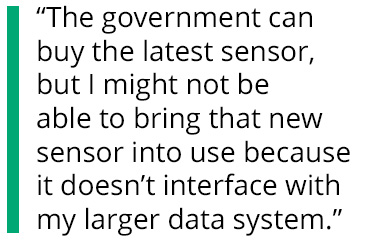
“It was really, really insightful in both directions,” says Newbern. “It allowed the participants to understand the missions and the problems and the pain points. It also allowed companies the opportunity to give some feedback on things that the Border Patrol leadership should be thinking about or doing, or how technologies could be applied to their situation.”
The central question that Newbern and his industry academy colleagues were confronting in their interactions with Border Patrol agents is, in many ways, the question at the center of immigration reform on Capitol Hill: What does effective border security look like? Senators and representatives from both parties are talking about utilizing the latest in “technology” but practical details are scant, or entirely missing from the discussion. So, what is the available technology and how should it be implemented?
***
There are voices on the left flank of the Democratic Party that advocate for significantly reducing entry enforcement, but across the political spectrum there is more consensus on maintaining border security than on nearly any other immigration issue. An overwhelming majority of Republicans and Democrats agree that some effective border security is necessary, and that any so-called grand bargain on immigration reform must start with this central premise. Even Charles Kamasaki, who has for decades worked with UnidosUS (a Latino advocacy group formerly known as National Council of La Raza), an organization clearly on the left, told Ideaspace in 2020: “Regardless of where one is on the spectrum of more or less immigration it seems to me you have to start with the basic principle that every sovereign nation gets to enforce its borders however it chooses.”
This general consensus intensified in the weeks and months after 9/11. It was at this critical juncture that Customs & Border Protection, or CBP, was folded into the newly formed Department of Homeland Security and given a “national security” mandate. At the time, there was not a documented case of a terrorist attack initiated by someone crossing into the U.S. by way of the southern or northern borders and there hasn’t been in the 20 years since, but the broader reinterpretation of border security as national security remains in place. The necessity of strong border security is a given for leaders of both parties, in campaigning and in policy-making.
While the federal government has for more than a century been incorporating new methods and technologies into its mission to secure the nation’s borders — armed aerial surveillance in 1919, surveillance towers in the 1940s, motion detectors in the early 1970s, to name just a few — the idea of a “virtual wall” has taken on new momentum now that Donald Trump is out of the White House and both Republicans and Democrats can move on from the debate over Trump’s envisioned physical border wall.
 “Smart border technology” is the term du jour, generally referring to the effort to harness the best of modern tools as surveillance infrastructure, freeing CBP’s human resources — that is, Border Patrol agents and customs officers — to respond to threats. President Biden has championed this approach in his proposed U.S. Citizenship Act of 2021, which includes provisions for “smart technology [to] manage and secure the southern border.” Likewise, Representative Maria Salazar, a Republican from Florida, uses similar language in her Dignity Proposal, which is currently the only publicized attempt within her party to tackle comprehensive immigration reform. While Salazar and her staff are still working on the final language of her bill, the one-page outline she released in March calls for “a full border infrastructure system [to] maintain operational control of the southern border.”
“Smart border technology” is the term du jour, generally referring to the effort to harness the best of modern tools as surveillance infrastructure, freeing CBP’s human resources — that is, Border Patrol agents and customs officers — to respond to threats. President Biden has championed this approach in his proposed U.S. Citizenship Act of 2021, which includes provisions for “smart technology [to] manage and secure the southern border.” Likewise, Representative Maria Salazar, a Republican from Florida, uses similar language in her Dignity Proposal, which is currently the only publicized attempt within her party to tackle comprehensive immigration reform. While Salazar and her staff are still working on the final language of her bill, the one-page outline she released in March calls for “a full border infrastructure system [to] maintain operational control of the southern border.”
Describing this infrastructure can get technical — and quickly.
“How geeky do you want me to get?” asks Charles Armstrong.
Armstrong worked in CBP’s Office of Information and Technology for over a decade, departing as Chief Information Officer in 2016. He now works as a consultant to purveyors of the latest technology. “[We have ] a lot of AI [Artificial Intelligence] platforms and cloud technologies out there today,” Armstrong says. “I think there are some very real possibilities for building effective infrastructure, for being able to get data and pull it into these artificial intelligence systems and feed that up into the chain so that the supervisory level can strategize how to deploy resources to meet threats — that’s certainly big.”
The latest models come and go, Armstrong emphasizes, and it’s important not to get too caught up in the shiny objects. “There’s obviously newer generations of cameras and sensors, radar packages and things like that that have more capabilities. The challenges aren’t so much about keeping up with the latest products but really more about understanding how best to deploy them.”
Armstrong and other experts Ideaspace spoke to suggest that border security spending and policy-writing should focus on two interconnected challenges: one, compatibility among devices provided by different contractors and, two, fully utilizing the latest developments in data sharing and analysis.
Most of the cutting edge technology is, in one form or another, a sensor. There are devices at ground level that detect heat or movement or sound. Even cameras are, in effect, sensors, using visual data to detect activity.
Cameras and other sensors are perpetually getting more precise with the data they provide, and the devices themselves are often taking new forms. Think about all the ways a camera can be deployed — a drone, a driverless ATV, an ambulatory robot. This opens the door to more private companies jumping into the border security industry, which has been growing steadily for the past two decades. Between 2008 and 2020, CBP — along with Immigration and Customs Enforcement, or ICE — issued 105,997 contracts worth $55.1 billion to private corporations.
 The Border Security Technology Consortium, or BSTC, pools resources and networks among 127 dues-paying corporate members to help develop and pilot border security products. The organization pilots new products and matches inventors with larger manufacturers. Kay Olive, who in addition to her senior role at WHSR is a co-founder of BSTC, says, “We had a woman who is the exact type of person our consortium targets. She had patents on 32 different technologies and she said, ‘Look, I’m an inventor. I cannot afford to bring these to market. I’m here because I want to talk to the Lockheeds and the Boeings and the Raytheons, because if I can partner with them, they can afford to bring it to market and I can keep inventing.’”
The Border Security Technology Consortium, or BSTC, pools resources and networks among 127 dues-paying corporate members to help develop and pilot border security products. The organization pilots new products and matches inventors with larger manufacturers. Kay Olive, who in addition to her senior role at WHSR is a co-founder of BSTC, says, “We had a woman who is the exact type of person our consortium targets. She had patents on 32 different technologies and she said, ‘Look, I’m an inventor. I cannot afford to bring these to market. I’m here because I want to talk to the Lockheeds and the Boeings and the Raytheons, because if I can partner with them, they can afford to bring it to market and I can keep inventing.’”
With so much competition for a bite of the multi-year $55-billion pie, most players guard intellectual property rigorously and remain resistant to designing “open source” products that are fully interoperable. So while each new toy might be impressive on its own terms, there are systemic issues when it comes to getting devices to communicate and work collaboratively.
“Obviously industry invests a lot, they want to protect that intellectual property as much as they possibly can,” says Phil Landfried, who, like Armstrong, has served as CBP’s Chief Information Officer (2016-2020). “But for the government, [the effect is] not good. We bought a lot of equipment in my time and everybody is proprietary and that gets in the way of building comprehensive surveillance. Let’s say I’ve got a simple sensor that says there is a vibration in one particular spot, and I have a camera that I can swing and look at that same area. Sometimes I can’t figure out how to merge that data because the two systems are proprietary.”
Landfried argues that in order to make field devices function to their full potential, each supplier should be required to meet certain open network standards. “The government can buy the latest sensor, but I might not be able to bring that new sensor into use because it doesn’t interface with my larger data system. So if there were guiding standards that allow CBP to say, ‘Okay, it is plug and play. We can bring in this new sensor, it can start feeding data in almost immediately.’ Then we can keep my technology current. Because we’ll never be done. It’s one of those things where you’re constantly going to evolve and get better. But if you get to where CBP can say to contractors, ‘Here’s the standard, here’s how we want sensors to communicate,’ I think that would go a long way to solving the problem.”
 Establishing standards such as those described by Landfried could be accomplished two different ways. Required open network specifications could get built into CBP’s contracts with outside contractors; this would fall under the authority of the Department of Homeland Security. Alternatively, open network standards could be established by legislation, if the standards were included in the text of President Biden’s U.S. Citizenship Act of 2021 or Representative Salazar’s Dignity Proposal. Crafting open network standards legislatively would allow the government to specify what it needs to build communicative networks but also allow private contractors to protect proprietary information in order to make a profit.
Establishing standards such as those described by Landfried could be accomplished two different ways. Required open network specifications could get built into CBP’s contracts with outside contractors; this would fall under the authority of the Department of Homeland Security. Alternatively, open network standards could be established by legislation, if the standards were included in the text of President Biden’s U.S. Citizenship Act of 2021 or Representative Salazar’s Dignity Proposal. Crafting open network standards legislatively would allow the government to specify what it needs to build communicative networks but also allow private contractors to protect proprietary information in order to make a profit.
If government standards can be set for making devices from different purveyors communicate with one another, it clears the way to address the second challenge singled out by Armstrong: sharing and sorting through the mounds of data produced by sensors. Devices on the market today can pick up details as fine as footprints and breath — but not all the information is applicable to the mission of securing the border. A mountain lion crossing an international line doesn’t warrant a response from an agent, but it does generate surveillance data.
The old model goes something like this: A Border Patrol agent stares at a laptop in a truck out on patrol, or at a desk back at the local station, trying to figure out if activity coming through a camera feed is a real border intrusion or not. If it is determined to be a real intrusion, the agent then communicates to supervisors that agents should be deployed to the area. All those steps take time and give the detected intruder an opportunity to get across the border before any agent can arrive.
Today, most field devices have an AI component which uses algorithms to make an initial determination about the viability of a threat before it gets bumped to an agent for review. “The newer cameras,” says Armstrong, “can discern between a person or an animal. That doesn’t necessarily have to go back into the big data center, it’s actually happening at a closer level — at the point where the device is collecting data.”
Armstrong points out that advancements in AI allow agents to shift more of their time to responding to intrusion threats instead of searching for them. “That’s another big opportunity,” he says, “the ability to use AI autonomy to enhance the boots-on-the-ground mission. There’s a lot of robotic technology that’s out there today, autonomous vehicles and so forth. How do you utilize that kind of technology to help give you a better kind of force multiplier?”
In order to increase, or multiply, the force that CBP is able to deploy at the borders, the agency has historically sought to increase the overall number of CBP personnel. From 1992 to 2020 the number of Border Patrol agents alone — not including customs officers at ports of entry — increased more than 475 percent, from 4,139 to 19,740. Smart border technology presents an opportunity for those with budgetary authority to redirect resources that have previously gone into increasing the overall number of agents toward other “force multipliers” — tools like AI and robotics that allow CBP to deploy agents more efficiently.
***
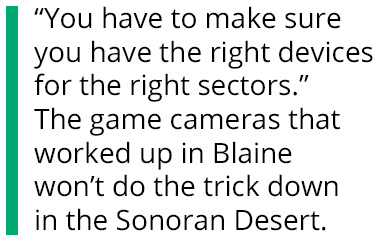
Aerovironment, where Newbern has worked for 25 years, provides approximately $10-$15 million worth of equipment annually to Border Patrol, with multiple devices in every sector. The company’s UAVs (Unarmed Aerial Vehicles) already have AI capabilities and Newbern spends much of his time focused on bringing those capabilities to different devices.
“It’s not just the design of the device itself that’s important but it’s the capability that you can provide.” Newbern envisions an AI platform with various devices that pass information back and forth, surveilling in concert. Perhaps, for example, an acoustic sensor provides initial data indicating activity, then that sensor requests more data from a pivoting camera, which, having received the request, surveilles the specified location. Depending on the data from the camera, the platform could deploy an automated robotic response, which could provide one more layer of data, if required, or simply maintain overwatch until agents arrive. “Ultimately,” says Newbern, “the AI is collecting data and giving guidance and an agent has to go act on it. “
As an example of a foundation for one sensory network, Newbern points to Aerovironment’s Quantics system, which uses UAVs to create detailed, real-time aerial mapping. “In 45 minutes you could map 40 acres autonomously,” he says. “You draw a box on the map where you want the device to go and it performs the entire mission, comes back and you have a stitched together, updated map [showing changes to terrain].”
While Quantics has primarily been used in the agricultural market, helping farmers know when more water or fertilizer might be needed in a particular field, Newbern says that the possibilities for the border region are apparent. “You could use this passively, it doesn’t really take an operator to do this mission. The system flies out, collects the data, stitches the imagery — and we’re talking ground resolution good enough to probably see footprints and that kind of thing. That allows the AI within the system to look for changes and that gives agents an understanding of the environment and maybe anything that has taken place. Basically, you create an alarm system that takes very few agents to operate.”
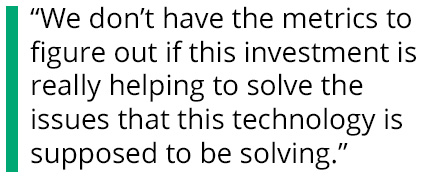 The challenge, Newbern says, is making sure that integrated systems still allow for each border sector to use the particular devices that suit that terrain. With big cities and open deserts, rivers and mountains, forests and lakes, the U.S. borderlands are intensely varied. “It’s not a one-size-fits-all approach,” says Armstrong. “You have to make sure you have the right devices for the right sectors.” The game cameras that worked up in Blaine won’t do the trick down in the Sonoran Desert.
The challenge, Newbern says, is making sure that integrated systems still allow for each border sector to use the particular devices that suit that terrain. With big cities and open deserts, rivers and mountains, forests and lakes, the U.S. borderlands are intensely varied. “It’s not a one-size-fits-all approach,” says Armstrong. “You have to make sure you have the right devices for the right sectors.” The game cameras that worked up in Blaine won’t do the trick down in the Sonoran Desert.
***
Ports of entry, in particular, are an important part of the border terrain to consider when it comes to customizing surveillance networks. Border Security conversations often overlook ports of entry, despite the fact that the majority of contraband is intercepted by customs officers at ports of entry, not by Border Patrol agents, whose mission is to monitor the spaces between ports of entry. Drug trafficking is often one of the most cited concerns when it comes to border security; in 2020, drug seizures by customs officers dwarfed those made by Border Patrol agents — 2,264 to 558 — and this is consistent with totals for the last several years.
Many ports are already outfitted with a battery of sensors: radiation detectors for atomic weapons; density readers to detect items covertly packed into vehicle panels; x-ray machines to scan trucks. Allowing legal crossings to happen as efficiently as possible while weeding out the bad actors is a conflicted mandate: go fast but be careful. In 2007, the San Diego Association of Governments estimated in a lengthy report that wait times at U.S. ports of entry cost the country $1.5 billion in revenue and 9,000 jobs — numbers that have likely increased in the years since. Armstrong says this is where AI can be better utilized in the form of facial recognition. Building facial recognition databases, he says, takes away the need for customs officers to check identifications. Not only does this speed up legal crossings but, says Armstrong, it gives CBP data that can be shared with other law enforcement agencies and private companies as part of a bigger security apparatus.
“Let me give you an example for a use of facial recognition technology that applies to ports and areas between them,” says Armstrong. “Over the years, we’ve had big problems with spotters [criminal actors surveilling law enforcement’s movements] on the other side of the border. We would monitor them with the cameras in the ports, but if you had the ability to capture those images and then keep that database and vet those images, then you could alert the federales in Mexico, ‘Hey, the bad guys are watching us as we’re operating on our side. They must be doing something on your side.’” Whereas CBP officials can, at present, alert Mexican law enforcement only of perceived threats, shared facial recognition data, Armstrong argues, would allow CBP to alert their Mexican counterparts to the presence of specific individuals who might be known or wanted or both.
Privacy issues are the most documented concern when it comes to the kind of surveillance networks that define smart border technology. And while privacy concerns in the border region sound like a marginal issue to Americans in other regions of the country, it’s important to remember that CBP maintains jurisdiction 100 miles from any external boundary, including coastlines, which ends up encompassing much of the country. Roughly two-thirds of the U.S. population live within the jurisdiction of CBP.
What’s more, CBP often works with state and local law enforcement agencies inside and outside of these 100-mile zones, creating “force multipliers” for enforcement efforts. The agency’s existing biometric system contains data on 250 million people and they’ve put the technology to use across the country. In 2020, CBP aerially surveilled Black Lives Matter protests in 15 cities.

The idea of a “border region” becomes even more amorphous when considering the U.S. maintains Border Patrol stations in places like Ireland, the United Arab Emirates, Panama, and Canada, as well as other nation-states where passage to the U.S. is monitored before it begins. The privacy concerns raised by smart border technology will inevitably affect all Americans, particularly with the ever-increasing budget allocated to CBP. Consider that the budgets for immigration and border policing increased from $1.2 billion in 1990 to $25.2 billion in 2019 — more than a 2,000-percent jump in less than 30 years.
“What are the effects of this infrastructure, of the virtual walls?” asks Guadalupe Correa-Cabrera, an associate professor at George Mason University and the editor of the academic journal, International Studies Perspective. “If you compare the costs and benefits of this technology, this is where we really don’t know how effective these devices are. We don’t know the effects of technology on the interdiction of drugs or stopping undocumented migrants. We don’t have the metrics to figure out if this investment is really helping to solve the issues that this technology is supposed to be solving.”
CBP keeps track of apprehensions at the border but this data point reveals little in isolation. Annual apprehension figures don’t reveal how many individuals tried to cross the border — some individuals get caught more than once and the number says nothing about how many people elude CBP. There is no baseline data to use to determine the efficacy of any given border security tool.
Even Scott Newbern, who stands to gain from growing border security budgets, agrees that the lack of metrics is a problem. “We don’t have a good simulation model for the border,” he says. “In my interactions with Border Patrol leadership and DHS, they did not have anything that allowed you to actually simulate the border dynamics. For instance, you could say, ‘Here’s a scenario where on one portion of the border we’re going to put 30 agents on patrol, on another portion we’re going to put 10 agents with UAVs and on another we’re going to put a camera system on the ground and only two agents. Those kinds of scenarios that would allow you to understand this force multiplication effect.”
What’s more, Border Patrol apprehensions are, by and large, economic migrants and asylum-seekers, categories that can, of course, overlap. If national security remains the paramount objective, then it’s helpful to avoid conflating economic migrants with those who pose serious criminal or national security threats. “You do have people that are looking to immigrate versus somebody who’s bringing drugs or [other contraband],” says Landfried. “We can all get behind something like, ‘Look, here’s somebody who’s bringing drugs to the country, we want to stop that.’ That’s a threat versus somebody who is trying to migrate. That has to come into play in the border security discussion.”
Several former CBP officials suggested that border security infrastructure should go beyond the obvious sensory networks, AI, and cloud sharing used on American soil, to include efforts to stop potential migrants before they make the journey. Alan Bersin, who has served as commissioner of U.S. Customs and Border Protection, as well as assistant secretary and chief diplomatic officer for the U.S. Department of Homeland Security, argues this is the most important part of any smart border security technology discussion. “Border security is a migration management issue,” he says. “This is about dealing with the issue, not at the borderline, but dealing with this issue as far away from the border as you can get geographically.”
Bersin argues that borders are often misunderstood as the country’s first line of defense when they’re more like the last line of defense. One tool to reduce illicit traffic at the border, Bersin says, is to set up more regional processing centers for asylum seekers and economic migrants throughout the Americas. “The tremendous hypocrisy of the advocacy community on the left is that their whole open border thing rests on putting migrants through this terrible journey with smugglers. We should remove this dependence on smugglers by saying, we’re going to create safe zones in countries where people can apply for asylum and be protected. Because what that would do right away is eliminate thousands of people massing to the border and paying smugglers to [get them there and across] it.”
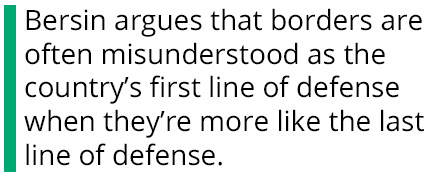 Correa-Cabrera, like Bersin, argues that border security should be viewed more expansively. Working on her book Los Zetas Inc: Criminal Corporations, Energy, and Civil War in Mexico, she spent years studying cartels and says part of border security infrastructure should be resources to address law enforcement corruption on both sides of the country’s borders. “This corruption,” she says, in a nod to the notion of a “virtual wall,” “creates ‘virtual tunnels’ and ‘virtual bridges’ for the criminals.”
Correa-Cabrera, like Bersin, argues that border security should be viewed more expansively. Working on her book Los Zetas Inc: Criminal Corporations, Energy, and Civil War in Mexico, she spent years studying cartels and says part of border security infrastructure should be resources to address law enforcement corruption on both sides of the country’s borders. “This corruption,” she says, in a nod to the notion of a “virtual wall,” “creates ‘virtual tunnels’ and ‘virtual bridges’ for the criminals.”
When it comes to the economic migrants and asylum-seekers who show up at the U.S. border, Correa-Cabrera echoes Bersin’s point that border security is, in large part, a migration management issue. Addressing these migrants can be much more effective when doing so before they reach the border. “If the United States has so much capacity, so much money,” she says, “how come Border Patrol was not prepared for the arrival of the Haitians? Those of us who study migration know when these people are starting their journey in countries like Brazil, like Chile. And there’s a place where you can see where they are, when they are coming — the Darien Gap in Central America. And Border Patrol didn’t calculate what would happen?”
In the meantime, the Biden administration has signaled a full-throated commitment to updating the nation’s border security infrastructure with the latest in cutting-edge technologies. In his testimony to the Senate Homeland Security and Governmental Affairs Committee in July of this year, DHS Secretary Alejandro Mayorkas detailed the $1.2 billion dollars included in Biden’s 2022 budget for modernizing port and border security.
“This is absolutely essential to protecting our homeland in the 21st century,” said Secretary Mayorkas. “I urge you respectfully to support the President’s requested investments for these smart and strategic border security measures.”
###
Read More:
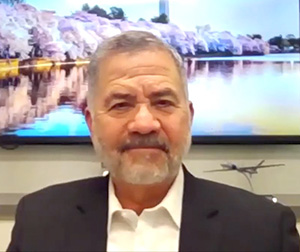

Capitol Hill Briefing No. 4




